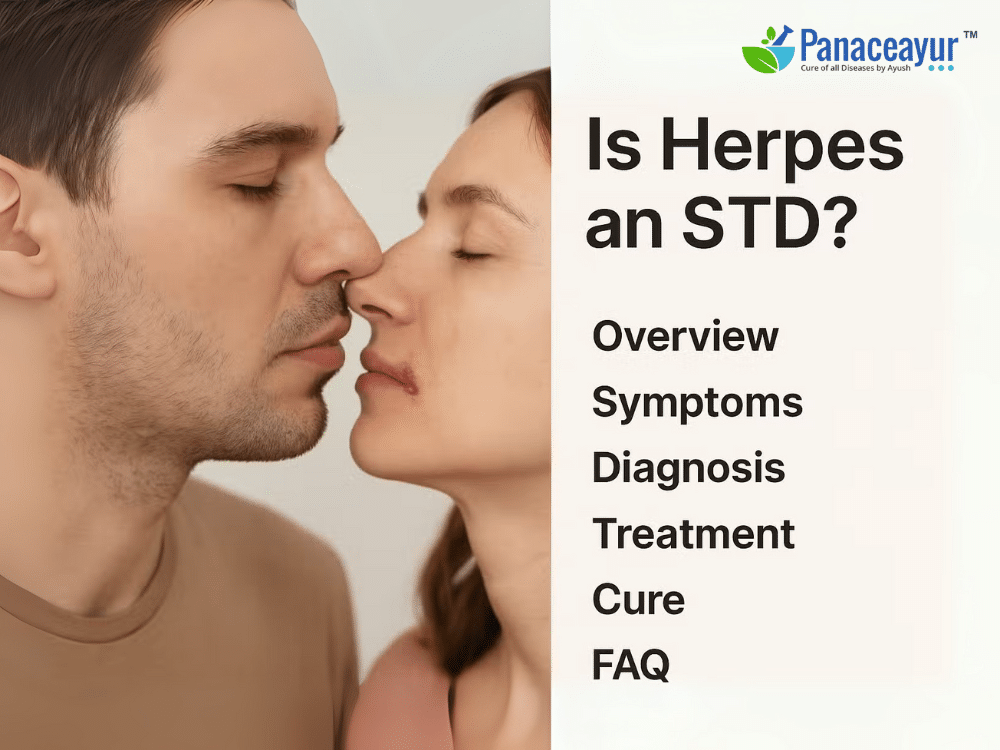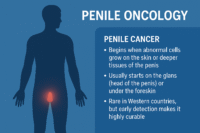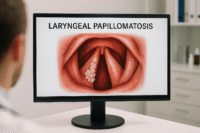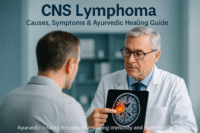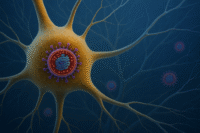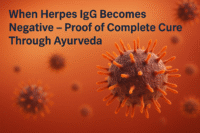- Understanding Herpes – The Basics
- What Is an STD?
- Is HSV-1 an STD?
- Is HSV-2 an STD?
- Predominant Mode: Sexual Contact
- Transmission Through Invisible Oral Cuts
- A Classic STD—Medically Speaking
- Ayurvedic Interpretation of HSV-2
- Can You Get Herpes Without Sex?
- Can Herpes Spread Without Symptoms?
- Symptoms of Herpes- Beyond Just Sores
- Diagnosis-Is There a Blood Test for Herpes?
- How Long Does Herpes Stay in the Body?
- Treatment-Can You Get Rid of Herpes Permanently?
- Cure- How Long Does It Take to Cure Herpes Naturally?
- Herpes and Asymptomatic Shedding
- Frequently Asked Questions(FAQs)
- 1. Is herpes considered an STD or STI?
- 2. Can you get herpes without having sex?
- 3. Is HSV-1 also an STD?
- 4. What are the first signs of herpes?
- 5. Can you have herpes and not know it?
- 6. Is herpes curable or only manageable?
- 7. Can I spread herpes without symptoms?
- 8. Does herpes affect fertility or pregnancy?
- 9. Can condoms prevent herpes transmission?
- 10. How does Ayurveda view herpes as an STD?
- 11. What’s the difference between HSV-1 and HSV-2?
- 12. Can HSV-1 cause genital herpes?
- 13. Which is more severe: HSV-1 or HSV-2?
- 14. Can someone have both HSV-1 and HSV-2?
- 14. Can someone have both HSV-1 and HSV-2?
- 15. Is it possible to spread herpes when no sores are visible?
- 16. How long does herpes shedding last?
- 17. Can herpes be diagnosed without symptoms?
- 18. Does having herpes mean someone was promiscuous?
- 19. Can I get herpes from a toilet seat or towel?
- 20. How does Ayurveda explain asymptomatic carriers?
- 21. Does genital herpes affect fertility in men or women?
- 22. Is it safe to get pregnant with herpes?
- 23. Can herpes be passed to the baby during childbirth?
- 24. Can I have a healthy relationship if I have herpes?
- 25. Should I tell my partner I have herpes?
- 26. How does herpes affect mental health?
- 27. Is there a permanent cure for herpes?
- 28. What does Ayurvedic treatment focus on for herpes?
- 29. Can herpes symptoms disappear completely?
- 30. Is there hope for people living with herpes?
- References
A Comprehensive Exploration from Virology to Ayurveda
Herpes is one of the most common viral infections worldwide, yet it remains one of the most misunderstood. The question “Is herpes an STD?” is more than just a technical inquiry—it carries emotional, social, and medical weight. Many people discover they have herpes only after experiencing symptoms or through routine testing, and the label of a “sexually transmitted disease” often comes as a shock.
Clinically, herpes simplex virus (HSV) includes two major types: HSV-1 and HSV-2. Both can cause oral and genital sores, and both can be transmitted through various routes—not only sexual contact. However, the moment herpes is classified under the STD category, the conversation changes. Stigma creeps in. Patients begin to view themselves as contaminated, and the healthcare system often responds with generic advice focused on suppression rather than cure.
This narrow framing can be misleading. While it is true that genital herpes is commonly transmitted through sexual activity, oral herpes is not always sexually acquired. Children can get HSV-1 through non-sexual contact. Many people carry the virus without symptoms, unknowingly spreading it during everyday interactions like kissing or sharing utensils [1].
The oversimplified label of “STD” leads to three key problems:
- It hides the fact that herpes is a systemic, neurotropic virus, not just a skin-level infection [2].
- It discourages people from seeking early diagnosis due to social fear and shame [3].
- It blinds both patients and providers to integrative solutions, including Ayurvedic strategies that target the virus at its root rather than merely suppressing outbreaks [4].
In this article, we will explore whether herpes should be classified strictly as an STD. You will learn how modern medicine defines and treats herpes, how the virus behaves in the body, and how ancient Ayurvedic science interprets it differently. By the end, you’ll see why rethinking herpes is not just medically necessary—it is emotionally liberating.
Understanding Herpes – The Basics
Herpes is caused by a group of viruses known as the herpes simplex viruses (HSV). There are two major types: HSV-1, which is traditionally associated with oral infections, and HSV-2, which typically causes genital herpes. However, this division is becoming increasingly blurred as both types can infect oral and genital areas depending on the mode of transmission [1].
Both HSV-1 and HSV-2 are neurotropic viruses, meaning they have a unique ability to hide in the nervous system. After initial exposure—through skin contact, sexual interaction, or even oral contact in childhood—the virus moves through sensory nerves and becomes dormant in the dorsal root ganglia near the spine [2]. This latency allows it to evade the immune system and re-emerge under conditions like stress, weakened immunity, menstruation, or other infections [3].
What makes herpes particularly deceptive is its ability to remain asymptomatic in most people. Research suggests that up to 80% of HSV-positive individuals don’t know they carry the virus because they have no visible symptoms, yet they can still transmit it to others [4]. This silent transmission is one of the key reasons why herpes continues to spread globally—even among people in monogamous relationships.
The symptoms, when present, usually include:
- Tingling, itching, or burning sensation in the infected area
- Painful blisters or ulcers on the lips, genitals, or surrounding areas
- Flu-like symptoms such as fever, fatigue, and swollen lymph nodes in initial outbreaks
- Nerve pain or urinary discomfort in some genital cases
Over time, many individuals notice a pattern of recurrence, which can range from monthly to once every few years. While the frequency usually decreases with time, the virus remains in the body indefinitely unless addressed with deeper immune or antiviral strategies.
Herpes is also linked to broader health concerns. In addition to causing visible outbreaks, HSV has been associated with increased susceptibility to HIV, complications during childbirth, and rare but serious conditions like herpes encephalitis (brain infection) [5].
In Ayurveda, herpes is not viewed merely as a surface-level disease but as a systemic imbalance involving the Rakta (blood), Pitta (heat), and Majja (nervous tissue). The virus’s ability to hide and reappear aligns with the Ayurvedic concept of Vyadhi Sanskara—a latent, recurring disorder that demands purification (Shodhana) and rejuvenation (Rasayana) for complete elimination [6].
Understanding herpes as a deep, chronic, and systemic condition rather than simply a sexually transmitted one is key to breaking the stigma and pursuing more effective, curative options.
What Is an STD?
The term STD, or sexually transmitted disease, refers to infections primarily spread through sexual activity—whether vaginal, anal, or oral. These infections typically pass from one person to another through bodily fluids like semen, vaginal secretions, or blood, or through direct skin-to-skin contact during intercourse [1].
Medical organizations such as the Centers for Disease Control and Prevention (CDC) and the World Health Organization (WHO) use the term STD (or STI—sexually transmitted infection) to categorize conditions like chlamydia, gonorrhea, syphilis, HIV, and genital herpes. The defining factor is sexual transmission as the main mode of spread [2].
However, not all infections that are sexually transmissible are exclusively sexually transmitted. This is where herpes challenges the conventional definition.
Herpes simplex virus (especially HSV-1) can spread through:
- Kissing
- Sharing eating utensils
- Childhood exposure from family members
These are non-sexual forms of transmission that fall outside traditional STD criteria [3].
Even HSV-2, which is more strongly associated with genital infection, can remain dormant and transmit without sexual contact once introduced into the host. In some cases, it has been documented in newborns infected during childbirth, known as neonatal herpes, without any sexual act involved [4].
This complexity has led many experts to adopt a broader term—sexually transmissible infection (STI)—which focuses on possible routes of transmission, not just sexual activity [5]. But in common usage, the public still refers to herpes as an “STD,” often with fear and shame attached to the label.
From a patient’s perspective, this classification matters. If someone contracts oral HSV-1 from a childhood exposure, they may never associate it with a sexually transmitted disease. But if they later have a genital outbreak caused by HSV-1 through oral-genital contact, they’re suddenly told they have an STD—often with no prior understanding or sexual history that would prepare them for such news.
This inconsistent messaging leads to:
- Stigma and confusion about disease origin
- Relationship stress, including blame or guilt
- Mental health concerns linked to identity, sexuality, and disclosure
Ultimately, the classification of herpes as an STD is technically accurate in some cases, but insufficient to fully describe how the virus behaves or spreads. It also fails to reflect the non-sexual, neurological, and immunological dimensions of the disease [6].
Ayurvedic medicine does not use the category of “STD” at all. Instead, it classifies diseases based on the route of entry, affected Dhatus (tissues), and Dosha imbalance, which offers a more individualized and systemic approach to understanding conditions like herpes.
Is HSV-1 an STD?
Herpes Simplex Virus Type 1 (HSV-1) is most commonly known as the cause of oral herpes—manifesting as cold sores or blisters around the lips and mouth. For decades, it was not considered a sexually transmitted infection. In fact, most people contract HSV-1 in childhood through non-sexual contact such as kissing, sharing utensils, or exposure to saliva from caregivers [1]. However, with changing sexual practices and delayed childhood exposure in modern hygiene-focused societies, HSV-1 has increasingly become a cause of genital herpes via oral-genital transmission [2].
HSV-1 Often Spreads Non-Sexually
The majority of HSV-1 infections worldwide still occur during early life, well before sexual debut. Studies estimate that over 70% of adults globally carry HSV-1 antibodies, often acquired during childhood in the absence of sexual behavior [3]. This foundational fact challenges the narrow classification of HSV-1 as a traditional STD.
Microtransmission Through Tiny Cuts and Blood Exposure
Beyond mucosal contact, HSV-1 can also spread through micro-abrasions and tiny cuts that allow blood or tissue fluid exchange. For example, during toothbrushing, a small gum bleed can occur. If the same individual engages in oral contact with a partner who also has a small oral abrasion, it creates a potential pathway for HSV-1 to transfer through microscopic blood exposure [4]. This kind of non-sexual yet intimate transmission is underrecognized and includes risks such as sharing razors, toothbrushes, or any tool that contacts bleeding oral tissues. Such possibilities further weaken the argument for HSV-1 being labeled strictly as an STD.
HSV-1 as a Genital Infection
In many developed countries, fewer children are exposed to HSV-1 early in life due to improved hygiene. As a result, they remain unexposed until adolescence or adulthood. When oral-genital contact occurs, HSV-1 can establish itself in the genital region. Research shows that genital HSV-1 now accounts for as many as 50–70% of new genital herpes diagnoses in some Western populations [5]. Though it may be located genitally, the source is often oral, and the mechanism of infection is not always sexual.
Clinical Behavior Differs from HSV-2
Genital HSV-1 has lower recurrence rates and reduced asymptomatic shedding compared to HSV-2. This means that it is less likely to cause frequent outbreaks and has a lower risk of silent transmission to partners [6]. Nonetheless, the psychological impact of receiving an “STD” diagnosis after a non-sexual or misunderstood exposure can be severe, especially in people who acquired HSV-1 orally and only later experience genital symptoms.
Ayurvedic Understanding of HSV-1
Ayurveda classifies HSV-1 not by its route of transmission but by its impact on tissues and internal balance. It falls under the broader category of Aupasargika Roga—contagious diseases—and is associated with disturbances in Rakta (blood), Majja (nervous tissue), and Twak (skin) [7]. HSV-1 is seen as a systemic imbalance aggravated by weakened Ojas (vital energy) and disturbed immunity. It may remain latent for years, reactivating during stress, inflammation, or compromised vitality. Importantly, Ayurvedic treatment is not localized—it addresses the terrain: purifying blood, strengthening immunity, and rejuvenating deeper tissues using Rasayana therapy.
Is HSV-2 an STD?
Herpes Simplex Virus Type 2 (HSV-2) is widely classified as a sexually transmitted disease (STD), and rightly so—most infections occur through sexual contact. However, its true nature goes beyond typical definitions of STDs. HSV-2 is a neurotropic virus that lodges in the sacral nerve ganglia, establishing latency and causing recurrent outbreaks in the genital area [1].
Predominant Mode: Sexual Contact
HSV-2 is most commonly acquired through vaginal or anal intercourse, but even genital-to-oral or skin-to-skin contact is enough for transmission. What sets HSV-2 apart is that it can transmit even when no visible symptoms are present—a phenomenon called asymptomatic shedding. Studies have shown that this silent viral shedding accounts for over 70% of new infections, making it difficult to trace or prevent [2].
Transmission Through Invisible Oral Cuts
While HSV-2 is less commonly transmitted through kissing compared to HSV-1, rare cases do occur where HSV-2 is spread through microscopic cuts or abrasions inside the mouth. For instance, a person with HSV-2 genital infection may have brief oral shedding or contact that coincides with tiny, unnoticed oral wounds—such as those caused by brushing teeth, flossing, or eating hard food. During deep kissing or oral sex, if the partner has similar invisible breaks in their mucosal lining, the virus can enter the bloodstream or tissue fluid and establish infection [3].
This form of blood-mediated or microabrasion-based transmission, although rare, further reveals that HSV-2 is not confined to sexual activity alone—especially when combined with weakened immunity or mucosal inflammation. Such underrecognized routes highlight the need to view herpes as a systemic and opportunistic infection, not simply a sexually contracted virus.
A Classic STD—Medically Speaking
HSV-2 fulfills all clinical criteria for an STD:
- Sexual transmission is the primary route.
- Genital symptoms such as blisters, itching, and pain are common.
- It increases the risk of HIV and other infections due to mucosal breaches.
- It shows higher prevalence in sexually active populations [4].
Globally, HSV-2 affects over 490 million adults aged 15–49, with women disproportionately affected due to thinner genital mucosa and higher tissue permeability during intercourse [5].
Ayurvedic Interpretation of HSV-2
Ayurveda classifies HSV-2 under Aupasargika Vyadhi (contagious disorders) and conditions like Upadansha and Yoni Vyapad—diseases of the reproductive tract featuring genital ulcers, pain, and discharge [6].
HSV-2 is understood to disturb:
- Rakta Dhatu (blood tissue)
- Majja Dhatu (nerve tissue)
- Shukra Dhatu (reproductive fluid)
- Apana Vata Srotas (pelvic channels)
The Beeja Bhava (viral seed) is said to embed itself deeply into the Dhatus, creating cyclic reactivation. Ayurvedic therapies such as Rasayana (rejuvenation), Shodhana (detox), and Ojas-building protocols aim to cleanse the viral memory from the tissues, enhance immunity, and restore energetic balance [7].
Can You Get Herpes Without Sex?
Yes, herpes can be transmitted without sexual activity. This often surprises many people, especially since herpes is commonly labeled a sexually transmitted disease (STD). However, both HSV-1 and, more rarely, HSV-2 can spread through non-sexual contact, depending on the situation and immune status of the individuals involved [1].
Non-Sexual Transmission Pathways
HSV-1, which typically causes oral herpes, is most often acquired during childhood through casual interactions:
- Kissing from family members
- Sharing utensils or drinking glasses
- Using the same towels or lip balm
This type of exposure does not involve sexual contact but still leads to lifelong infection, as the virus travels via nerve endings to the trigeminal ganglion, where it remains dormant [2].
HSV-2 is less commonly spread non-sexually, but certain routes exist:
- Transmission via micro-abrasions from contaminated objects (e.g., shared razors)
- Transfer through invisible cuts in the oral cavity during kissing, especially if a partner has an active or asymptomatic genital HSV-2 infection [3]
Although rare, HSV-2 has been documented in cases where blood contact, mucosal exposure, or medical negligence (e.g., contaminated surgical tools) were involved.
Why It Matters
Labeling herpes purely as an STD reinforces stigma and limits public understanding of how the virus actually behaves. People may carry herpes for years without knowing, or acquire it in a completely non-sexual context, and still face judgment due to misconceptions.
Ayurvedic View on Non-Sexual Transmission
Ayurveda describes herpes under Aupasargika Roga (contagious diseases) and recognizes multiple modes of entry:
- Direct contact (sparsha yoga)
- Kiss or shared item (samparka dosha)
- Weakened immunity (Ojas kshaya)
It emphasizes that infection occurs not just through physical proximity, but due to a susceptible internal environment—such as vitiated Rakta and Majja Dhatus, blocked Srotas, or low Agni (digestive/metabolic power) [4].
Even if exposure is minimal, the body’s terrain determines whether the virus will remain dormant, activate, or be cleared altogether.
Can Herpes Spread Without Symptoms?
Yes, herpes can absolutely spread even when no symptoms are visible. This is one of the most misunderstood aspects of the virus, making it difficult to control and leading to its widespread global prevalence. This silent form of transmission is known as asymptomatic shedding, and it plays a major role in the ongoing spread of both HSV-1 and HSV-2 infections [1].
What Is Asymptomatic Shedding?
Herpes viruses can reactivate in the body without causing noticeable symptoms like blisters or pain. During these episodes, the virus becomes active in the skin or mucous membranes and is shed from the surface, even if no outbreak is occurring. This is known as asymptomatic viral shedding. The person may feel perfectly fine—and yet still be contagious [2].
- Studies have shown that up to 70% of genital herpes transmissions occur when the infected partner had no visible signs at all [3].
- Shedding is most common in the first year after infection, but can continue for life.
- Even antiviral medications like Acyclovir do not completely prevent shedding, although they reduce its frequency.
Real-World Examples
- A person with HSV-2 who has no symptoms for months can still infect their partner during intimate contact.
- HSV-1 can spread through a simple kiss—even without cold sores—if shedding is active in the oral cavity.
- Sharing items like towels, lip balm, or razors during asymptomatic phases can lead to transmission, especially in individuals with compromised immunity.
Ayurvedic Understanding of Asymptomatic Spread
In Ayurvedic medicine, this silent viral activity corresponds to a “Sookshma Krimi Avastha”—a subtle, unmanifested state of pathogenic invasion. The virus remains dormant (Nidra Avastha) within deeper Dhatus (such as Majja Dhatu and Shukra Dhatu) and periodically awakens based on internal triggers like:
- Ojas depletion
- Suppressed Agni (digestive fire)
- Emotional or sexual overexertion
- Srotas blockage
The shedding phase aligns with an energetic imbalance in the Rakta-Majja Srotas, where no symptoms may be present externally, yet viral activity persists microscopically. This explains why Rasayana therapies in Ayurveda focus on restoring immunity, detoxifying the deeper Dhatus, and re-establishing Srotas flow, not just clearing surface-level symptoms [4].
Why This Matters
Many individuals assume they are not contagious if they feel healthy. Unfortunately, this misconception fuels silent transmission across relationships. This is why comprehensive treatment strategies—whether conventional or Ayurvedic—must address latent viral load, not just symptom relief.
Symptoms of Herpes- Beyond Just Sores
The symptoms of herpes can vary widely, depending on the type of virus (HSV-1 or HSV-2), the site of infection, and the individual’s immune response. While some people experience intense, painful outbreaks, others may carry the virus silently for years.
Oral Herpes (HSV-1):
Oral herpes typically presents with painful blisters or sores around the lips, gums, and mouth. These are often preceded by a tingling, burning, or itching sensation, which signals viral reactivation. In children and first-time exposures, it may also cause fever, swollen lymph nodes, and difficulty swallowing during primary outbreaks [1].
Genital Herpes (Usually HSV-2, but also HSV-1):
Genital herpes often causes painful ulcers, swelling, redness, and burning during urination. Women may also experience vaginal discharge, while men report sensitive lesions on the penis or scrotum. Recurrent episodes tend to be less severe but can still lead to emotional stress and sexual discomfort [2].
Silent Infections (Asymptomatic Herpes):
A significant percentage of individuals—up to 80%—remain completely asymptomatic, never realizing they are infected. Despite the lack of symptoms, they can still transmit the virus through asymptomatic viral shedding [3].
Systemic and Neurological Symptoms:
In some individuals, especially those with weakened immunity or chronic reactivations, herpes can lead to fatigue, low-grade fevers, neuralgia (nerve pain), headaches, and a weakened immune response over time. HSV can affect the autonomic nervous system and is associated with chronic pelvic pain, fibromyalgia-like symptoms, and post-viral fatigue syndromes in rare cases [4].
Ayurvedic Perspective
In Ayurveda, these manifestations relate to Rakta Dushti (vitiation of blood), Majja Dhatu imbalance (nervous tissue), and blocked Srotas (channels), especially under aggravated Pitta and Vata conditions. Silent infections are seen as Avyakta Krimi Vyadhi, a hidden microbial pathology affecting the Ojas (vital essence) without overt signs [5].
Diagnosis-Is There a Blood Test for Herpes?
Yes, blood tests are available for detecting herpes—but they come with both strengths and limitations. Unlike tests for many other infections, herpes testing is not always straightforward and can sometimes lead to confusion if not interpreted correctly. Understanding what these tests measure—and what they don’t—can help patients make informed decisions about diagnosis and treatment [1].
Types of Herpes Tests
- PCR Swab Test (Gold Standard for Active Infection)
- Detects the DNA of the herpes virus directly from a lesion.
- Most accurate during an active outbreak.
- Cannot detect latent infection if no sores are present.
- Detects the DNA of the herpes virus directly from a lesion.
- Type-Specific Blood Antibody Test (IgG)
- Detects antibodies (IgG) to HSV-1 and HSV-2 in the bloodstream.
- Useful for identifying past exposure.
- Can distinguish between HSV-1 and HSV-2.
- May take 2–16 weeks after exposure to become positive.
- Detects antibodies (IgG) to HSV-1 and HSV-2 in the bloodstream.
- IgM Antibody Test (Less Reliable)
- Previously used to detect recent infection.
- Not recommended by the CDC due to high false-positive rates.
- Previously used to detect recent infection.
Limitations of Blood Tests
- A positive IgG result indicates exposure, not necessarily an active infection.
- Cannot tell where in the body the virus resides (oral or genital).
- Some people with herpes never develop detectable antibodies.
- Many routine health checkups don’t include HSV testing unless specifically requested [2].
Should You Get Tested?
Blood testing is useful in the following situations:
- You’ve had unprotected sex and want clarity—even without symptoms.
- Your partner has herpes and you want to assess your own risk.
- You’re planning pregnancy or starting a long-term relationship.
However, if you have never had symptoms, a positive result can raise emotional distress without necessarily indicating active risk. That’s why patient counseling is key before and after testing.
Ayurvedic Interpretation
In Ayurveda, no direct blood test exists, but the state of Rakta Dhatu and Majja Dhatu can be assessed through signs like:
- Chronic fatigue, burning sensations, neuralgia
- Delayed wound healing
- Skin eruptions triggered by heat, stress, or seasonal changes
Advanced practitioners use Nadi Pariksha (pulse diagnosis) and dosha-Dhatu mapping to detect dormant viral influence. According to Ayurvedic pathology, a Dushta Rakta-Majja-Srotas combination signals latent pathogenic presence—even when no symptoms manifest externally.
Thus, while modern blood tests provide objective confirmation, Ayurvedic diagnostic methods guide root-cause therapies targeting the deeper tissues and not just the virus surface markers.
How Long Does Herpes Stay in the Body?
Once the herpes virus enters the body, it typically stays for life. Both HSV-1 and HSV-2 are known for their ability to establish lifelong latency within the nervous system. After the initial infection, the virus travels through sensory nerve endings and takes shelter in nerve ganglia—most commonly the trigeminal ganglion for HSV-1 and the sacral ganglia for HSV-2 [1]. In this dormant state, the virus becomes invisible to the immune system and antiviral drugs.
Viral Latency and Reactivation
The hallmark of herpes infection is its ability to reactivate under certain triggers—such as stress, fever, menstruation, weakened immunity, trauma, or exposure to sunlight. During reactivation, the virus travels back to the skin or mucosal surface, causing lesions or, in many cases, shedding without symptoms [2]. This cycle of latency and reactivation may continue indefinitely, although the frequency of outbreaks tends to reduce over time in most individuals.
There is no known method in modern medicine to remove the herpes virus completely from the body. Antiviral medications, such as Acyclovir or Valacyclovir, suppress viral replication and reduce symptoms and transmission risk, but they do not eliminate the latent virus [3]. This is why herpes is considered a chronic, recurring viral condition.
Asymptomatic But Still Present
Even when no visible symptoms are present, the virus can still shed intermittently. Studies confirm that people who have had only one outbreak or none at all can still experience viral shedding from mucosal surfaces [4]. This means the virus can be transmitted even when the individual feels completely healthy.
Ayurvedic Understanding of Viral Persistence
In Ayurveda, this persistent state of herpes correlates with the “Vyadhi Sanskara” concept—where a disease leaves behind an imprint or tendency within the body. This imprint is stored in the Majja Dhatu (nervous tissue) and Shukra Dhatu (reproductive fluids), depending on the viral location [5]. The virus may not be active but remains embedded as a Sookshma Krimi (subtle pathogen).
When the balance of Doshas is disturbed—especially Pitta and Vata, along with Ojas depletion—the dormant virus is reawakened. This results in cyclic flare-ups, resembling how Bija Bhava (seed-like conditions) reactivate diseases in susceptible terrain. Hence, Ayurvedic treatment goes beyond suppressing flare-ups and aims to remove the Beeja (seed), strengthen Dhatu resistance, and restore Ojas.
Treatment-Can You Get Rid of Herpes Permanently?
In conventional medicine, herpes is considered a lifelong viral infection with no known cure. Both HSV-1 and HSV-2 establish latency in the nervous system, meaning the virus hides in nerve ganglia, often for the person’s entire life. Standard treatments, such as Acyclovir, Valacyclovir, and Famciclovir, are designed to suppress outbreaks and reduce transmission, but they do not eliminate the virus from the body [1]. As a result, the mainstream medical consensus is that herpes cannot be cured, only managed.
Why Modern Medicine Believes It’s Incurable
The primary reason herpes is considered incurable is due to its ability to establish neurotropic latency. After the initial infection, the virus travels along the sensory nerves and nests in the trigeminal ganglion (HSV-1) or sacral ganglion (HSV-2). These nerves are highly protected from immune surveillance, and the virus becomes transcriptionally silent, making it invisible to the immune system and unaffected by antiviral drugs [2]. Even cutting-edge gene therapies and vaccines have not yet succeeded in clearing the virus from these protected sites [3].
The Ayurvedic Approach: Root-Cause Elimination
Ayurveda takes a fundamentally different view. Rather than classifying herpes as an incurable condition, it sees the infection as a Vyadhi Sanskara—a chronic imprint or tendency left behind in the Dhatus (tissues), especially the Majja Dhatu (nerve tissue), Rakta Dhatu (blood), and Shukra Dhatu (reproductive fluids) [4].
The goal in Ayurvedic therapy is not just outbreak control but Beeja Shodhana—the elimination of the “viral seed” from the tissue memory. This involves:
- Shodhana (detoxification) via Panchakarma to purge deeply embedded viral residues
- Rasayana (rejuvenation) therapy using immune-restorative herbs and minerals
- Bhasma formulations (e.g., Gandhak Rasayan, Swarna Bhasma, Abhrak Bhasma) to penetrate the deepest Dhatus and destroy dormant viral presence [5]
Ayurveda also emphasizes restoring Ojas, the vital essence of immunity, which acts as a natural antiviral shield. If Ojas is replenished and Srotas (body channels) are unblocked, viral latency can be broken, and recurrence may stop permanently [6].
Clinical Evidence from Ayurvedic Practice
There is growing anecdotal and clinical evidence that Ayurvedic protocols—especially those combining Rasayana, Bhasma, and dietary regulation—can lead to:
- Complete cessation of outbreaks
- Negative HSV PCR results over time
- Improved sexual and reproductive health
- Emotional relief from the stigma of a “lifelong infection” [7]
Although large-scale scientific validation is still ongoing, several Ayurvedic physicians report sustained remission in herpes patients using time-tested formulations found in classical texts like Charaka Samhita, Rasa Tarangini, and Bhaishajya Ratnavali.
While modern medicine continues to search for a pharmaceutical cure, Ayurveda offers a holistic, immune-based pathway to potentially eliminate the virus’s footprint from the body. This is not suppression but transformation—restoring the body’s inner terrain so the virus can no longer survive. In that sense, herpes may not be incurable, but instead deeply misunderstood.
Cure- How Long Does It Take to Cure Herpes Naturally?
The timeline to cure herpes naturally—particularly through an Ayurvedic approach—depends on several factors, including the individual’s immunity (Ojas), viral load, dhatu involvement, and consistency in following the treatment protocol. Unlike pharmaceutical antivirals that offer short-term suppression, Ayurvedic medicine focuses on long-term eradication by restoring balance in the body’s inner terrain and addressing the root cause of latency [1].
Influencing Factors in Natural Cure Duration
- Chronicity and Dosha Involvement: If the virus has remained latent for several years, it typically resides in deeper Dhatus—especially Majja (nervous tissue) and Shukra (reproductive tissue)—making the treatment more complex. Vata dominance delays healing by impairing cellular memory and nerve vitality [2].
- Strength of Agni and Ojas: Weak digestion (Agni) and depleted Ojas slow down the body’s ability to regenerate healthy Dhatus and eliminate residual virus. Hence, Rasayana and Agni-deepana herbs are prioritized early in the protocol [3].
- Presence of Co-infections or Autoimmune Load: Conditions like CMV, EBV, or HIV co-infection or autoimmune tendencies (e.g., eczema, Hashimoto’s) require deeper detoxification (Shodhana) before Rasayana therapy can work effectively [4].
- Diet, Sleep, and Lifestyle: The body’s healing timeline is directly affected by factors like sleep patterns, stress levels, exposure to viral triggers, and compliance with a sattvic diet. Spicy, oily, or processed foods delay purification of Rakta and Rasa Dhatus [5].
General Timeline Based on Clinical Experience
- Mild to moderate cases (HSV-1 or HSV-2, <1 year): 3–6 months with Rasayana + targeted Bhasma therapy.
- Chronic or recurring cases (2+ years with frequent outbreaks): 9–12
- Severe nerve-embedded latency (silent but high viral load): May require 12–18 months with deeper protocols including Abhrak Bhasma, Gandhak Rasayan, and Swarna Makshik etc in staged doses [6].
Modern Research Parallel
Emerging studies suggest that immune-modulatory herbs like Ashwagandha, Kalmegh, and Licorice show significant anti-HSV activity in vitro and may inhibit viral replication and entry into nerve cells [7]. When paired with lifestyle correction, meditation, and Ojas-building practices, this integrative approach often leads to sustained remission.
Unlike suppressive drugs, Ayurveda works by removing the “Beeja” (seed) of the virus and rebuilding Dhatu strength. The process is gradual, but evidence shows that a personalized protocol rooted in Dosha, Prakriti, and Srotas understanding—can lead to permanent cessation of recurrence, viral inactivity, and emotional healing [8].
Note: This is a purely customized treatment protocol. The medicines, minerals, and Rasayanas are tailored specifically to your Dosha, Prakriti, level of Dhatu involvement, and overall immune status. There is no one-size-fits-all approach in Ayurvedic herpes treatment.
Herpes and Asymptomatic Shedding
One of the most misunderstood aspects of herpes is the phenomenon of asymptomatic shedding when the virus is active on the skin or mucosa but shows no visible symptoms, such as blisters, ulcers, or itching. During this time, a person can still transmit the virus to others without knowing they are contagious [1].
Silent but Contagious
Even individuals who have never experienced a noticeable outbreak can still carry and shed the herpes simplex virus (both HSV-1 and HSV-2) at various times. Studies show that asymptomatic shedding accounts for the majority of new HSV transmissions, especially among intimate partners who were unaware of the infection status [2].
- HSV-2 tends to shed more frequently in the genital region
- HSV-1 primarily sheds in the oral region
These episodes are intermittent, unpredictable, and more likely to occur:
- In the first 12 months after primary infection
- During stress, illness, or menstrual cycles
- When immunity is weakened
- Even after years of dormancy [3]
How Asymptomatic Shedding Happens
The virus remains latent (dormant) in the nerve ganglia, such as the trigeminal ganglion (HSV-1) or sacral ganglia (HSV-2). During reactivation, it travels down the nerve pathways to the skin, even if no lesions appear. This is the point at which it can be shed through skin cells or secretions [4].
Ayurvedic Interpretation
In Ayurvedic terms, this matches the concept of Avyakta Lakshana—a disease process where the Krimi (subtle pathogens) remain hidden within Majja Dhatu (nervous tissue) and Rakta Dhatu (blood). Even without external signs, they continue to vitiate internal Srotas (channels) and gradually weaken Ojas (vital immunity), facilitating transmission through subtle routes like touch or shared secretions [5].
Implications for Prevention
Because individuals can unknowingly transmit herpes, this makes:
- Honest communication with partners
- Use of barrier protection
- Regular diagnostic testing all the more critical—even in the absence of symptoms [6].
Modern research is now exploring how certain Ayurvedic Rasayana therapies and nerve-specific Bhasmas (like Suvarna Makshik and Ras Sindoor) may help reduce viral reactivation and latency shedding cycles, though more trials are needed to validate these protocols scientifically.
Frequently Asked Questions(FAQs)
1. Is herpes considered an STD or STI?
Yes, herpes is classified as a sexually transmitted infection (STI). Both HSV-1 and HSV-2 can spread through oral, vaginal, or anal contact. While HSV-1 was traditionally seen as a non-STD virus (causing cold sores), it is now a leading cause of genital herpes, transmitted through oral sex.
2. Can you get herpes without having sex?
Yes. Herpes can spread through skin-to-skin contact, kissing, or sharing utensils, lip balms, or razors. This is particularly true for HSV-1, which can be acquired in childhood through non-sexual contact.
3. Is HSV-1 also an STD?
HSV-1 is now a common cause of genital herpes, especially in developed countries. Though it typically causes oral cold sores, it becomes an STD when transmitted through oral-genital contact.
4. What are the first signs of herpes?
Early signs include tingling, itching, pain, redness, and fluid-filled blisters in the oral or genital area. Some people may also feel flu-like symptoms such as fatigue or fever. Many cases, however, remain asymptomatic for years.
5. Can you have herpes and not know it?
Yes. Up to 80% of herpes carriers are unaware they’re infected, due to asymptomatic viral shedding. This makes herpes one of the most silently transmitted STDs in the world.
6. Is herpes curable or only manageable?
Modern medicine currently considers herpes incurable, offering antivirals to manage symptoms and reduce transmission risk. However, Ayurveda approaches herpes as a curable viral condition, using Rasayana therapy, viral-inhibiting herbs, and Dhatu-level cleansing to target latent viral load.
7. Can I spread herpes without symptoms?
Yes. This is known as asymptomatic shedding, and it’s the primary mode of transmission for many new cases. Shedding can happen days before or after an outbreak—or even with no outbreak at all.
8. Does herpes affect fertility or pregnancy?
Herpes does not affect fertility, but genital herpes during pregnancy can lead to neonatal herpes, a rare but serious condition. Caesarean delivery may be recommended if active lesions are present during labor.
9. Can condoms prevent herpes transmission?
Condoms reduce risk, but they don’t fully prevent transmission, since herpes can spread through skin not covered by a condom. Suppressive antiviral therapy and communication with partners are also important.
10. How does Ayurveda view herpes as an STD?
In Ayurveda, herpes aligns with Agantuja Krimi Roga (externally acquired microbial diseases) involving Rakta Dushti, Majja Dhatu involvement, and vitiated Pitta-Vata dosha. Treatment focuses on purification (Shodhana), rejuvenation (Rasayana), and terrain correction, aiming to eradicate the viral nidus at the Dhatu level.
11. What’s the difference between HSV-1 and HSV-2?
HSV-1 typically causes oral herpes (cold sores), while HSV-2 primarily affects the genital region. However, due to changes in sexual behavior (e.g., oral sex), HSV-1 is now a leading cause of genital herpes, especially in young adults.
12. Can HSV-1 cause genital herpes?
Yes. If HSV-1 is transmitted through oral-genital contact, it can infect the genital area. Although HSV-1 genital infections may recur less often than HSV-2, they are still contagious and should be taken seriously.
13. Which is more severe: HSV-1 or HSV-2?
HSV-2 tends to recur more frequently and is more likely to cause painful genital outbreaks, while HSV-1 outbreaks are usually milder and more commonly appear around the mouth. However, both types can be equally distressing, depending on the immune response and nerve involvement [3].
14. Can someone have both HSV-1 and HSV-2?
Yes. It is possible to be infected with both strains, especially if exposed through different types of contact (e.g., oral and genital). Coinfection can result in more complex or confusing symptoms, especially during early outbreaks.
14. Can someone have both HSV-1 and HSV-2?
Yes. It is possible to be infected with both strains, especially if exposed through different types of contact (e.g., oral and genital). Coinfection can result in more complex or confusing symptoms, especially during early outbreaks.
15. Is it possible to spread herpes when no sores are visible?
Absolutely. This is called asymptomatic shedding, where the virus is present on the skin or mucosa but without any visible signs. Many people transmit herpes unknowingly during this stage.
16. How long does herpes shedding last?
Viral shedding episodes can last from several hours to a few days, depending on the individual and whether they’re on antiviral or immune-supportive treatment. HSV-2 sheds more frequently than HSV-1, especially in the genital region.
17. Can herpes be diagnosed without symptoms?
Yes. Blood tests can detect herpes antibodies (IgG/IgM) even if no outbreak has occurred. PCR swab tests during suspected outbreaks or mild tingling phases can also detect active viral DNA.
18. Does having herpes mean someone was promiscuous?
No. Herpes is so common that even one sexual encounter, or even non-sexual contact during childhood, can result in lifelong infection. Stigma stems from misunderstanding—not fact.
19. Can I get herpes from a toilet seat or towel?
Highly unlikely. HSV does not survive long outside the human body and requires direct mucous membrane or skin-to-skin contact. Transmission via inanimate objects (fomites) is extremely rare [9].
20. How does Ayurveda explain asymptomatic carriers?
Ayurveda describes such cases as Avyakta Krimi—a hidden pathogen residing in Rakta (blood) and Majja (nerve tissue) without visible symptoms. Despite this, it weakens Ojas (vital immunity) and disturbs internal Dosha-Srotas balance, increasing the risk of transmission without awareness [10].
21. Does genital herpes affect fertility in men or women?
No. Herpes does not directly affect fertility, sperm production, or ovulation. However, recurrent outbreaks or chronic inflammation may indirectly impact reproductive health by causing stress, discomfort, and pelvic complications, especially in women [1].
22. Is it safe to get pregnant with herpes?
Yes. Many women with herpes conceive and give birth safely. However, if a first-time outbreak occurs during pregnancy, especially late in the third trimester, there is a risk of neonatal herpes, a serious condition. Doctors may recommend C-section if active lesions are present during delivery [2].
23. Can herpes be passed to the baby during childbirth?
Yes. HSV can be transmitted to the baby during vaginal birth if the virus is actively shedding. This is why early diagnosis and planning with a healthcare provider are essential to reduce risks [3].
24. Can I have a healthy relationship if I have herpes?
Absolutely. With open communication, safe practices, and possibly suppressive therapy, people with herpes can maintain healthy, loving relationships. Many couples manage herpes successfully with honesty and mutual care [4].
25. Should I tell my partner I have herpes?
Yes. It’s ethically and legally important to inform your partner. When disclosed properly, many partners respond with support and understanding, especially when educated about asymptomatic shedding and risk reduction [5].
26. How does herpes affect mental health?
Many people with herpes report feelings of shame, anxiety, or depression—especially after initial diagnosis. However, these emotions often improve with education, support, and medical or Ayurvedic care. Mental health should be prioritized in any treatment plan [6].
27. Is there a permanent cure for herpes?
Modern medicine currently offers no definitive cure, only symptom suppression using antivirals. However, Ayurvedic medicine considers herpes curable by targeting the virus’s latent state in nerve tissues and Dhatus, using Rasayana herbs, mineral Bhasmas, and immune-regulating protocols that go beyond suppression [7].
28. What does Ayurvedic treatment focus on for herpes?
Ayurveda targets Rakta Dushti (blood toxicity), Majja Dhatu (nerve tissues), and impaired Srotas (microchannels). A combination of viral-cleansing herbs, rejuvenating Rasayana formulations, and immune enhancement (Ojas restoration) is used to eliminate hidden viral reservoirs and prevent recurrence [8].
29. Can herpes symptoms disappear completely?
Yes. In both modern and Ayurvedic care, symptoms can vanish, especially with lifestyle changes, immune support, and suppressive regimens. But true eradication of the virus at the source is what Ayurveda uniquely offers through deep-acting therapies [9].
30. Is there hope for people living with herpes?
Absolutely. Today, there is more awareness, advanced care options, and integrative approaches than ever before. Thousands of people are managing or eliminating herpes through evidence-based herbal medicine, emotional healing, and personalized guidance [10].
References
Is Herpes an STD? – A Scientific and Ayurvedic Perspective
This content is backed by a carefully selected set of references from both modern science and classical Ayurvedic literature to ensure clinical reliability, cultural context, and factual accuracy:
- World Health Organization (WHO, 2022) Global prevalence and burden of herpes simplex virus. https://www.who.int/news-room/fact-sheets/detail/herpes-simplex-virus
- Centers for Disease Control and Prevention (CDC, 2021) STD Treatment Guidelines – Herpes Simplex Virus. https://www.cdc.gov/std/treatment-guidelines/herpes.htm
- Tronstein, E. et al. (2011) Genital shedding of HSV-2 in symptomatic and asymptomatic persons. JAMA, 305(14), 1441–1449. https://doi.org/10.1001/jama.2011.420
- Xu, F. et al. (2006) Trends in HSV-1 and HSV-2 seroprevalence in the U.S. JAMA, 296(8), 964–973. https://doi.org/10.1001/jama.296.8.964
- Bernstein, D. I. et al. (2013) Epidemiology and clinical presentation of HSV-1 and HSV-2 genital infections. Clinical Infectious Diseases, 56(3), 344–351. https://doi.org/10.1093/cid/cis922
- Patel, R., & Alderson, S. (2021) Herpes simplex virus: Clinical guidelines. BMJ Best Practice. https://bestpractice.bmj.com/topics/en-gb/723
- Charaka Samhita – Chikitsa Sthana 1/28 Rasayana therapy and immunity regulation in chronic disorders. Translated by P.V. Sharma, Chaukhambha Orientalia, Varanasi.
- Sushruta Samhita – Chikitsa Sthana 9.13 Krimi Chikitsa and viral pathogenesis. Translated by K.K. Bhishagratna, Chowkhamba Sanskrit Series, Varanasi.
- Wald, A., & Corey, L. (2007) Epidemiology and persistence of HSV. In Human Herpesviruses: Biology, Therapy, and Immunoprophylaxis. https://www.ncbi.nlm.nih.gov/books/NBK47447/
- Chandran, P. K., & Patwardhan, B. (2008) Immunomodulatory activity of Ayurvedic Rasayana: Withania somnifera. Journal of Ethnopharmacology, 115(2), 262–267. https://doi.org/10.1016/j.jep.2007.10.014


